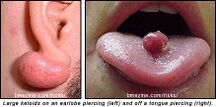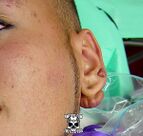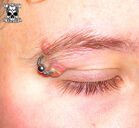Keloid
Keloids are a specific kind of fibrous scar tissue — most people make the mistake of assuming that all piercing-related scarring is keloiding, whereas hypertrophic scarring is much more common and easier to treat. As far as the use of the word "keloid," it is both a noun, and a verb. The verb, "to keloid" means to create these raised scars.
Keloiding is, in part, related to the amount of melanin in your skin; the darker your skin, the better you generally keloid. That's part of the reason why light skinned people have historically stuck to tattooing and dark skinned people have stuck to scarification (plus scarification shows up better than tattoos on dark skin). People who are genetically prone to keloids can pretty much leave their fresh scarification alone and be left with large, even raised, keloids, whereas other people will need to artificially irritate the wound in order to have it raise.
Keloid scars always extend well past the edges of the original wound/scar and tend to be darker in colour than hypertrophic scars.
Treatment
While one can try and treat keloid scarring with steroid injections such as triamcinolone to increase collagenase (an enzyme that breaks down collagen), it is not usually effective and surgical excision is often the only option. It should also be noted that even after excision keloids may re-occur. One reader warns, "After trying to have my scars removed surgically, they regenerated even bigger than their original size... so I caution anyone looking to have it removed in that manner: be very careful!!", and Kristin offers a similar caution:
- "I am one of the many that unfortunately have two keloids on both earlobes. I a so frustrated with these things. They itch, occasionally I have sharp pains going through them, and they stink. I have had the one removed surgically twice, a year apart by the same surgeon and it continues to grow and grow and grow. Just the other day I visited a dermotologist, what for I do not know. He assured me that after all of any surgery, steroid injections, radiation, and reconstructive surgery that they (keloids) would most likely come back. He informed me that he has more failures than successes wit keloids and said that he spends more time trying to talk people out of going through with than going through it. So after hearing that I have very little hope for having normal earlobes ever again."
Keloids are best avoided by minimizing the source of irritation (ie. taking out the piercing or changing the jewelry). That said, many people describe success with a variety of folk remedies (although it's important to note that many people misinterpret forms of hypertrophic scarring or even things like boils as keloids). A reader writes,
- "I have an industrail piercing and a month after I got it, I got a keiloid. It sort of just happened. I put tea tree oil on it every morning, night, and whenever I'd think about it, and within 4 weeks, it was gone!!"
Gabi writes to add,
- "To forgive a 'young' keloid the best solution I have tried is camomile three times a day for a month; it's not fast but it is efective."
However, it must be emphasized that in most cases true keloids will not respond to these types of treatments (many people mistake normal scarring for keloiding). Another reader writes about the surgical intervention she needed.
- "After having a lobe piercing (with a gun) for almost 2 years, and an industrial (with needles) for almost a year, and both had healed, I had begun to notice what I thought was hypertropic scarring. After switching jewelry and using vitamin E oil, the scar tissue only seemed to grow, until I realized it was keloiding. After a bit of denial, I finally removed the jewelry alltogether, but the scar tissue continued to grow.
- "Finally I went to a dermatologist to see what he could do about them. He recommended monthly injections of a steroid called kenalog, with eventual removal. The kenalog is supposed to soften the tissue, allowing it to become partially absorbed, and make removal easier and more successful. I also went to two other dermatologists (for purely logistical reasons), and all agreed on the treatment. After receiving four rounds of injections, I got the first keloid removed. Only one was done in order to see if scarring occurs during its healing process. Since I only got this done yesterday, I don't know how successful it will be, but the prospect looks good.
- "The actual removal procedure was quite simple — a few shots of anesthetic in my ear, the removal, then a few sutures. During the healing process, I'm applying bactroban (an antibiotic) twice a day, and gently cleaning it with mild soap and water once a day, and I'll continue this for the next week. In the meantime, I'll keep up with the monthly injections on the other two keloids until I'm able to get them removed as well.
- "I'd like to add that I was pleasantly suprised with my experiences with all three of the dermatologists I visited. I told them that the keloids were from piercings, and they passed no judgement on me whatsoever. I had been a little bit scared that I might be blamed for the keloids, but I never was. They all told me that keloids are little understood, hard to get rid of, and you may get them only in one part of your body, so you can never be sure that you are someone who 'doesn't keloid' (I got them only in my left ear, none in any of the four piercings in my right ear)."
It should also be noted that keloids don't always form just outside the piercing; they can actually form inside the fistula as well, as this reader writes,
- "I have a little, hard, lump in my earlobe, inbetween the piercing and my head. I was at first concerned that it might be an abscess or boil (although the only symptom present was tenderness), but then talked to a doctor about it. Conclusion? Keloid scar tissue, inside the ear."
A Dermatology professor in Madras India also asked me to add the following point (and also reminded me that it is not uncommon for teens to develop facial keloiding after picking acne),
- "Ear piercing is a risk for keloid formation, while nose piercing quite often leads to the formation of granuloma pyogenicum. This is noticed frequently in our (Indian) patients.The increased vascularity over the ala nasi compared to that over the ear lobe may be postulated as a cause. This finding should be recorded as an ethnic derma manifestation in India where nose piercing is practised most commonly as a ritual and recently turning to be a fashion."
Promoting Keloiding
In some scarification, such as branding and skin removal, consistently colored, raised keloids are actually the goal. However, keloid scarring is rarely even, and the scars may continue to grow over time, becoming tight and uncomfortable during movement. A preferable (and more likely) result will be caused by hypertrophic scarring.



